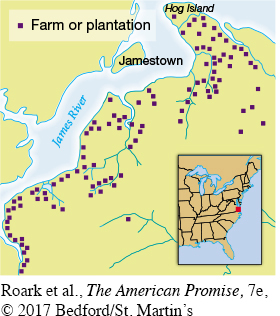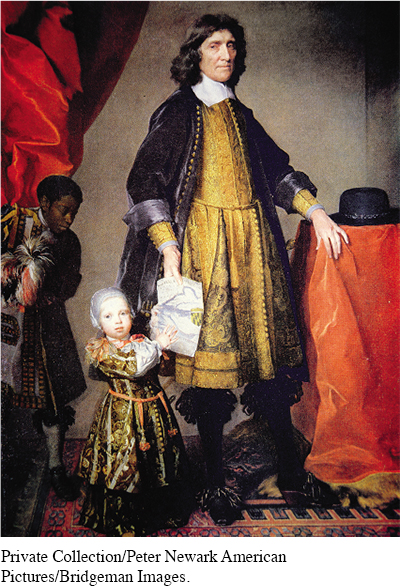The American Promise: Printed Page 63
The American Promise, Value Edition: Printed Page 59
The American Promise: A Concise History: Printed Page 70
Cultivating Land and Faith

Villages and small towns dotted the rural landscape of seventeenth-
Most Chesapeake colonists were nominally Protestants. Attendance at Sunday services and conformity to the doctrines of the Church of England were required of all English men and women. Few clergymen migrated to the Chesapeake, however, and too few of those who did were models of piety. Certainly, some colonists took their religion seriously. Church courts punished fornicators, censured blasphemers, and served notice on parishioners who spent Sundays “goeing a fishing.” But on the whole, religion did not awaken the zeal of Chesapeake settlers, certainly not as it did the zeal of New England settlers in these same years (as discussed in “Church, Covenant, and Conformity” in chapter 4). The religion of the Chesapeake colonists was Anglican, but their faith lay in the turbulent, competitive, high-

The situation was similar in the Catholic colony of Maryland. In 1632, England’s King Charles I granted his Catholic friend Lord Baltimore about six and a half million acres in the northern Chesapeake region. Lord Baltimore intended to create a refuge for Catholics, who suffered severe discrimination in England. He fitted out two ships, the Ark and the Dove; gathered about 150 settlers; and sent them to the new colony, where they arrived on March 25, 1634. However, Maryland failed to live up to Baltimore’s hopes. The colony’s population grew very slowly for twenty years, and most settlers were Protestants rather than Catholics. The religious turmoil of the Puritan Revolution in England (see “Religious Controversies and Economic Changes” in chapter 4) spilled across the Atlantic, creating conflict between Maryland’s few Catholics—
The American Promise: Printed Page 63
The American Promise, Value Edition: Printed Page 59
The American Promise: A Concise History: Printed Page 70
Page 65REVIEW Why did the vast majority of European immigrants to the Chesapeake come as indentured servants?